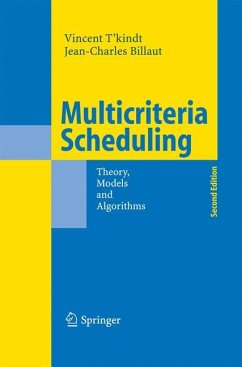Scheduling and multicriteria optimisation theory have been subject, separately, to numerous studies. Since the last twenty years, multicriteria scheduling problems have been subject to a growing interest. However, a gap between multicriteria scheduling approaches and multicriteria optimisation field exits. This book is an attempt to collect the elementary of multicriteria optimisation theory and the basic models and algorithms of multicriteria scheduling. It is composed of numerous illustrations, algorithms and examples which may help the reader in understanding the presented concepts. This book covers general concepts such as Pareto optimality, complexity theory, and general method for multicriteria optimisation, as well as dedicated scheduling problems and algorithms: just-in-time scheduling, flexibility and robustness, single machine problems, parallel machine problems, shop problems, etc. The second edition contains revisions and new material.
From the reviews of the second edition:
"The book is devoted to a particular class of scheduling problems, namely, to those that involve multiple criteria for the evaluation of the constructed schedules. This approach is highly motivated by practical needs, several examples of which illustrate the thesis well. ... The book is complemented by two appendices presenting, respectively, the notation of scheduling problems and a synthetic summary of the results presented. Summing up, I consider this book being a valuable introduction to the interesting field of multicriteria scheduling problems ... ." (Jacek Blazewicz, Zentralblatt MATH, Vol. 1126 (3), 2008)
"The book is devoted to a particular class of scheduling problems, namely, to those that involve multiple criteria for the evaluation of the constructed schedules. This approach is highly motivated by practical needs, several examples of which illustrate the thesis well. ... The book is complemented by two appendices presenting, respectively, the notation of scheduling problems and a synthetic summary of the results presented. Summing up, I consider this book being a valuable introduction to the interesting field of multicriteria scheduling problems ... ." (Jacek Blazewicz, Zentralblatt MATH, Vol. 1126 (3), 2008)








